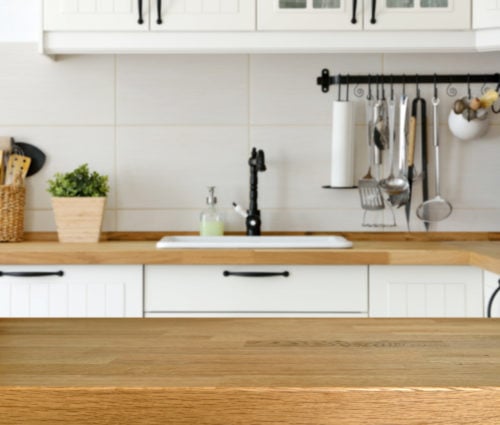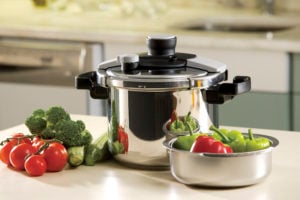Americans don’t spend enough time preparing and eating food—and their health suffers. Help is on the way! There are ways to turn healthy whole foods into easy, delicious fast meals.
A 2011 study reported in Forbes reveals what we all know, that Americans don’t like to spend extended time in the kitchen or even at the table. The Organization for Economic Cooperation and Development, a group of 34 mostly Western countries, found that Americans spend less than thirty minutes a day organizing, preparing and cleaning up meals compared to an OECD average of two hours and eight minutes. Americans also don’t take much time to eat the food they spend so little time with, about an hour and 14 minutes a day compared to an OECD average of an hour and 41 minutes.
While recognizing that correlation isn’t causation, it is noteworthy that the American obesity rate of 34% is double that of the OECD average. Not coincidentally, our life expectancy of 77.9 years is also below the OECD average of 79.3, despite having the highest expenditure per capita on health care.
Many nutritionists recognize the link between our minimalist approach to preparing and eating food, our movement away from fresh fruits and vegetables, grains and bean, berries and seeds and toward “fast” foods as playing a significant role in burgeoning lifestyle illnesses. Many studies show the links between the refined carbohydrates and “bad” fats in packaged and fast foods and metabolic disorder that leads to the chronic diseases of aging, including diabetes, heart disease, and some cancers. And yet we still don’t take time to prepare and eat whole food meals insisting we don’t have the time.

Enter some creative entrepreneurs in 2012 in response to those two sets of facts, that Americans don’t much want to put time into preparing and eating their food, and Americans develop lifestyle chronic diseases at record numbers, and they introduced “meal kits” as a solution. “Revenue is expected to grow to over ten billion U.S. dollars in 2020, from one billion in 2015.” Online meal kits, usually through subscription sales, are designed to eliminate the hassles of meal planning and grocery shopping. Fresh foods, often with “locally sourced” claims, arrive pre-measured and packaged with detailed instructions to complete preparation at home for a fresh “home-cooked” meal. 27% of internet users purchased meal kits through the internet in 2016.
But meal kits are not a solution for everyone. They are costly: although prices vary, and there are kits available for less money, the average per person price for a meal is $10. Consider that for a family of four, eating meal kits seven days a week costs $280 on average—and that’s only one meal per day! Add to that the packaging at a time we need to reduce use of disposables, and the energy involved in transporting items to a preparation and packaging point and from there to homes. We have a problem, Houston!
Maybe it would be a good idea to reconsider the time-worn option of preparing fresh whole foods meals at home. We just need ways to speed it up a little!
Back to the Future
So is this one of those anti-technology prompts to get back to our traditional methods of serving and enjoying meals? Well, yes and no. Study after study shows that the best path to vibrant health is to “Eat food. Not too much. Mostly plants,” in the words of food guru, Michael Pollan in Food Rules. But we can hardly force people to take time preparing food if they have demonstrated that they don’t want to do that. It’s a battle no one wins. But there is a solution, and that lies in technology.
In Catching Fire: How Cooking Made Us Human, Richard Wrangham tells us that based on research into closely related primates, we can estimate that before humans knew how to use and control fire, i.e., before cooking, it took our ancestors seven to eight hours a day to chew their food! That doesn’t leave much time for anything else. The technology of cooking allowed those who came before us to leap forward into the future of humanity. But of course, cooking technology doesn’t stop there, and today, we have items that allow us to prepare delicious, healthy, fresh, whole foods that are essential to vibrant health in a very short time.
So when you are ready to start cooking at home affordably and quickly for your health, consider how to choose kitchen products effectively and which are most important to get.
Choosing the Best Kitchen Products
Whether you’re starting a new kitchen or trying to get a fresh start in the kitchen you’ve always had, consider these features in setting up for quick, serious, delicious, nutritious cooking. Stoves and microwaves, small appliances and bigger ones are technologically advanced over the stoves our parents used, but they are also expensive with a basic set of kitchen appliances potentially involving thousands of dollars.
If you don’t have the space or the dollars for the latest in large kitchen appliances or the newest gadgets—and even if you do—consider these criteria in choosing what you want in your kitchen and accessible:
- Is the product compact, fitting easily into your kitchen? Have a plan for where you will work with a kitchen product and be certain it has a regular storage spot nearby.
- Is the product substantial and well-made? Commercial kitchen products are built to withstand hard and heavy use, and they are often available today for home kitchens. Remember we’re considering the most essential items for your kitchen, so these are things you will hope to use daily. Be sure what you get will stand up to that wear and tear.
- Is the product “efficient,” that is, will you use it daily, even for multiple processes? Does it do its job well? Is it easy to clean? These characteristics are important if you want to cook healthy whole food meals on a daily basis. A tedious use or cleanup job can leave any appliance sitting in the back of a cupboard, and it does no one any good there.
- Is the product safe? Is there an automatic shutoff if it overheats? Are there ways to keep hot parts or sharp blades away from little fingers? Is it tested and fully approved for its purpose?
- Do customer and independent reviews of the product indicate that it is truly be worth what it costs? Amazon has a great bank of customer reviews on most products you might consider buying. Customer reviews are very helpful, and it’s worth taking time to browse these thoroughly even if you don’t purchase through Amazon. When products have excellent reviews overall, read through the (almost) inevitable bad reviews carefully. You might find a little piece of information about something that doesn’t bother most people but will bother you.
Essential Kitchen Products to Help You Easily Cook Healthy Whole Foods in Small Spaces
Most home kitchens these days come equipped with the big four, a refrigerator/freezer, an oven with a range, a microwave and a dishwasher. With a smaller family, or for a quick meal, though, it’s not always desirable to fire up an oven or use a dishwasher. The basic items get expensive in a small cafe since they must be NSF-approved, and ovens and ranges require hoods. In food trailers and trucks, stoves and dishwashers are usually not feasible. There are some great products on the market, though, that trim cooking time and are great for turning whole foods into beautiful, nutritious meals.

1. High-powered blender.
High-powered blenders are available in many makes and models these days. The granddaddy of them all and the machine restaurateurs still prefer is VitaMix (VitaPrep in the commercial version). A VitaMix “breaks food down to the cellular level” in no time, mainlining whole food nutrition to the cells in your body.
A high-powered blender is essential for a basic healthy food item, a breakfast smoothie. You can make a half gallon of a nutrient-dense, thick, delicious “drink” in no time. And the really good news? For cleanup, just add a drop of soap to half a container full of hot water and blend for a couple of seconds. Empty, fill halfway with rinse water and blend.
2. Programmable multi-function cookers.
Everyone’s favorite gift for the holidays in 2017 was the Instant Pot, one of several programmable multi-function cookers on the market. With twelve and more functions, these pots saute, stew, slow-cook, pressure-cook, make hard-boiled eggs, incubate yogurt, and more. A variety of accessories make the pot even more versatile, but even without those accessories, meals are a breeze.
Throw in a bunch of seasonal vegetables with a little extra virgin olive oil, minced fresh garlic, water, amazing seasonings, and pressure for a few minutes…voila! It’s a soup or stew or a topping for pasta. Beans? Pressure them first with water for 30 minutes, then add other items and pressure a little more. Clean up is a breeze.
3. A good knife.
If you’re not a professional cook or cooking hobbyist, you might not pay much attention to your knife. You should. You should also learn how to use it. A good knife used skillfully makes excellent whole food meals in less time than it takes to haul out and clean a piece of equipment to do it for you.
4. A spiralizer.
You know those very professional-looking, beautiful dishes you see with reams of multi-colored spirals? Those beautiful dishes are also packed with good raw veggie nutrients and antioxidants. They make amazing salads, pasta substitutes, decorative main dishes and more. There are lots of fancy tools to accomplish this fancy result, but you don’t need it, not to mention, you have to assemble and clean those. A simple metal tool that looks like a vegetable peeler except that it has a saw-toothed edge works great.
5. Induction burners.
Induction burners take little space, use less energy than gas burners, heat instantly and turn off automatically when you remove your pot or pan. That protects you from accidentally leaving a burner on. The only problem is that the pots and pans you use with the burner must be stainless steel.
6. Cast iron Dutch oven.
All metal pots and pans shed into food that is cooked in them. Why not pick up some extra iron in your diet, something many of us can use, by cooking food in cast iron? Cast iron cooked foods have a distinct flavor and texture, and they’re especially fun to use in an indoor or outdoor fireplace. Older pans have a smoother surface and can be restored and re-seasoned. Newer pans have a more granular surface but can be purchased pre-seasoned. Lids will double as a frying pan. These versatile tools even make a great loaf of whole grain, no-knead, crusty bread. Foods don’t stick in properly seasoned cast iron, and there’s no dangerous teflon! Best of all, if you’re lifting cast iron every day, it’s like weight-lifting, so you can save money on a health club!!
With so many ways to cook whole foods easily and quickly and some great kitchen tools to help you turn out great, healthy meals, you can probably make up family meals … or an amazing range of items to serve your customers in a cafe … in less time than it takes you to decide between packaged food or going out to grab some fast food. Then you can relax and enjoy a meal with family or friends, letting the time and your healthy future stretch out before you.




